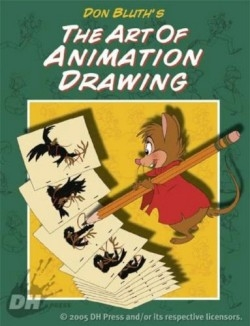The Art of Animation Drawing
The highly technical field of animation is the author/artist’s latest subject in this book, which covers everything that the aspiring animator needs, from finding a character to music and timing. While drawing for comics, manga, and graphic novels is complex enough, animation adds a geometric progression of complexity to the job, and Bluth takes time to explore each aspect, with plenty of examples.
The author, who has worked on movies ranging from The Secret of N.I.M.H to Anastasia, An American Tail to All Dogs Go to Heaven, relates anecdotes about how he developed characters, gives advice to new and would-be animators, and explains many technical aspects of the process of taking a character from initial sketch to finished film. He talks about the importance of the story line in developing the character, and how voice plays a part as well, offering as examples anecdotes about sessions with Burt Reynolds, Dom DeLuise, John Carradine, and Paul Shenar.
The story about Reynolds is particularly amusing, as Bluth relates the actor’s first attempt at recording a character for All Dogs Go to Heaven: “Suddenly, out of his mouth came this dismal, put-on cartoon character voice with absolutely zero believability … When Burt finally finished … he seemed pleased with himself … the lines never came to life.” The situation was resolved when Reynolds and DeLuise began to ad lib in the studio weeks later. The difference? “We could have made three movies with what the two stars delivered that day.”
Bluth also discusses the use of color, shape, size, and angle to create effects, define personality, and enhance atmosphere. He discusses rhythm as an important factor in animation, and advocates the use of the metronome to establish timing and get the “beat” of a scene relative to the speed of the film (twenty-four feet per second). He also talks about the “X-sheet” (the exposure sheet, which “represents every frame of the animated scene”), methods of calculating how many drawings are needed per second to depict a scene, and the value of thumbnails, which are, he says, the artist’s way of taking notes.
Songs tend to stop the action in an animated feature movie, Bluth points out, and he goes on to explain that if the lyricist and composer work closely with the animator, a song can actually advance the action, as in Anastasia, in which the animation action displays the character’s memories (for instance, rags become a ball gown, and images in portraits dance with Anastasia).
While far from being a textbook, this volume includes a technical glossary, and offers a good introduction into the more arcane aspects of animation logistics and craft, and will stand interested readers in good stead.
Reviewed by
Marlene Satter
Disclosure: This article is not an endorsement, but a review. The publisher of this book provided free copies of the book to have their book reviewed by a professional reviewer. No fee was paid by the publisher for this review. Foreword Reviews only recommends books that we love. Foreword Magazine, Inc. is disclosing this in accordance with the Federal Trade Commission’s 16 CFR, Part 255.

